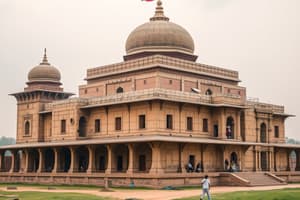Podcast
Questions and Answers
What is the scientific definition of distance?
What is the scientific definition of distance?
- How far apart two points are (correct)
- How fast an object moves
- The time taken for an object to travel from point A to B
- The force experienced by objects in motion
Which of the following is an example of rotational motion?
Which of the following is an example of rotational motion?
- Walking in a straight line
- Spinning a top (correct)
- Jumping up and down
- Driving a car along a highway
Why do rulers work best for measuring straight lines?
Why do rulers work best for measuring straight lines?
- They can measure curved shapes accurately
- They stretch exactly the length of what they measure without changing shape (correct)
- They are flexible and can be bent easily
- They change shape based on what they measure
Which concept is introduced later in the standard six physics syllabus for objects in motion?
Which concept is introduced later in the standard six physics syllabus for objects in motion?
What do objects in motion experience according to scientific terms?
What do objects in motion experience according to scientific terms?
Which method of measuring distance involves using triangles or trapezoids?
Which method of measuring distance involves using triangles or trapezoids?
What does the formula $d = s \times t$ represent?
What does the formula $d = s \times t$ represent?
If a car travels at 60 kmph for 2 hours, what distance does it cover?
If a car travels at 60 kmph for 2 hours, what distance does it cover?
How is displacement different from distance in motion?
How is displacement different from distance in motion?
What is a common error students make when solving motion problems?
What is a common error students make when solving motion problems?
In what real-world scenario would understanding motion concepts be helpful?
In what real-world scenario would understanding motion concepts be helpful?
Why do students find it challenging to understand mathematically modeled real-life situations?
Why do students find it challenging to understand mathematically modeled real-life situations?
Flashcards are hidden until you start studying
Study Notes
NCERT Science Class 6: Motion and Measurement of Distances
In the realm of science education, NCERT (National Council of Educational Research and Training) is renowned for its comprehensive and well-structured curriculum, which includes various disciplines such as mathematics, social studies, environmental studies, and more importantly, science. As we delve into the world of NCERT Science Class 6, one of the key concepts taught here is motion and distance measurements. Let's explore this fascinating subject together!
What Is Motion?
Motion refers to any change in position or location; it can be linear like walking, running, or driving, or rotational like turning your head or spinning something in circles. In other words, if you move from point A to B, you have experienced motion. In scientific terms, objects in motion experience forces—a concept introduced later in standard six physics syllabus.
Distance Measurements
Distance is defined as how far apart two points are. It typically involves measuring length using units such as meters or inches. There are several methods of measuring distances, including by observing shadows, direct observation, tape measures, and rulers. When measuring straight lines, rulers work best because they stretch exactly the length of what they measure without changing shape. However, when calculating curved shapes, you might need triangles, trapezoids, or even geometry software.
Important Formulae and Concepts
One fundamental formula used in distance calculations is ( d = s \times t), where 'd' represents the total distance traveled over time 't' at speed 's'. For example, traveling at a constant velocity of 70 kmph for three hours would mean covering a distance of 210 kilometers (( 70 \text{ kmp} / hour \times 3 \text{ hours})). This basic principle applies across all types of movements, whether through air, water, or space.
Moreover, students learn how to calculate displacement, another crucial aspect of motion. Displacement tells us how much ground has been covered during a journey rather than just the path taken. Although covering 80 kilometers due north may seem similar to going westwards at the same speed for the same duration, their actual displacements differ drastically – only the former changes location significantly while the latter remains stationary.
Real-World Applications
Understanding motion and distance measurements isn't merely theoretical knowledge confined within textbooks. These concepts permeate our daily lives, helping us estimate travel times, navigate complex routes, plan journeys efficiently, and even make sense of our surroundings visually. From GPS devices guiding drivers' paths accurately based on these principles to scientists determining trajectories of celestial bodies orbiting around each other billions of light years away - everywhere you look, there are traces of the laws governing motion and measurements of distance at play.
Misconceptions and Common Errors
Students often commit errors when dealing with motion problems involving speeds, velocities, accelerations, and distances. They frequently mix up these related but distinct quantities leading to incorrect solutions or misinterpretations. Plus, confusing real life situations with mathematical models presents additional challenges in understanding realistically modeled phenomenon.
Assessments and Examinations
The National Board of Secondary Education (NBSE) conducts examinations to assess student's proficiency in sciences, including motion-related subjects. Additionally, CBSE offers question papers online along with answer keys post-exam results. Solving practice questions helps reinforce learning outcomes and prepares students better for future exams.
In summary, studying motional aspects under NCERT Science Class 6 provides young minds exposure to basic principles underlying everyday phenomena - laying strong foundations towards higher levels of understanding physical world dynamics.
Studying That Suits You
Use AI to generate personalized quizzes and flashcards to suit your learning preferences.



